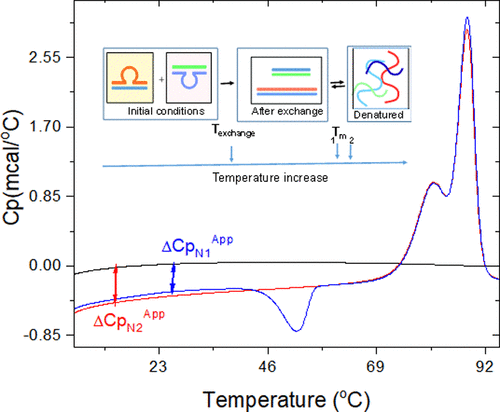当前位置:
X-MOL 学术
›
J. Phys. Chem. B
›
论文详情
Our official English website, www.x-mol.net, welcomes your
feedback! (Note: you will need to create a separate account there.)
Heat Capacity Changes (ΔCp) for Interconversions between Differentially-Ordered DNA States within Physiological Temperature Domains: Implications for Biological Regulatory Switches.
The Journal of Physical Chemistry B ( IF 2.8 ) Pub Date : 2020-06-12 , DOI: 10.1021/acs.jpcb.0c04065 Jens Völker 1 , G Eric Plum 2 , Kenneth J Breslauer 1, 3
The Journal of Physical Chemistry B ( IF 2.8 ) Pub Date : 2020-06-12 , DOI: 10.1021/acs.jpcb.0c04065 Jens Völker 1 , G Eric Plum 2 , Kenneth J Breslauer 1, 3
Affiliation

|
Knowledge of differences in heat capacity changes (ΔCp) between biopolymer states provides essential information about the temperature dependence of the thermodynamic properties of these states, while also revealing insights into the nature of the forces that drive the formation of functional and dysfunctional biopolymer “order.” In contrast to proteins, for nucleic acids there is a dearth of direct experimental determination of this information-rich parameter, a deficiency that compromises interpretations of the ever-increasing thermodynamic analyses of nucleic acid properties; particularly as they relate to differential nucleic acid (meta)stability states and their potential biological functions. Here we demonstrate that such heat capacity differences, in fact, exist not only between traditionally measured native to fully unfolded (assumed “random coil”) DNA states, but also between competing order-to-order transformations. We illustrate the experimental approach by measuring the heat capacity change between “native”/ordered, sequence homologous, “isomeric” DNA states that differ in conformation but not sequence. Importantly, these heat capacity differences occur within biologically relevant temperature ranges. In short, we describe a new and general method to measure the value of such heat capacity differences anywhere in experimentally accessible conformational and temperature space; in this case, between two metastable bulge loop states, implicated in DNA expansion diseases, and their competing, fully paired, thermodynamically more stable duplex states. This measurement reveals a ΔCp of 61 ± 7 cal molbp–1 K –1. Such heat capacity differences between competing DNA “native” ensemble states must be considered when evaluating equilibria between different DNA “ordered” conformations, including the assessment of the differential stabilizing forces and potential biological functions of competing DNA “structured” motifs.
中文翻译:

热容量变化(ΔCp)的生理温度域内的有序DNA状态之间的相互转换:对生物调节开关的影响。
的热容量的差异知识改变(Δ Ç p)生物聚合物状态之间的关系提供了关于这些状态的热力学性质对温度的依赖性的基本信息,同时还揭示了对驱动功能性和功能障碍性生物聚合物“有序”形成的力的本质的见解。与蛋白质相反,对于核酸,缺乏直接实验确定该信息丰富的参数的缺陷,这种缺陷损害了对核酸特性不断增长的热力学分析的解释。特别是它们与差异核酸(亚)稳定性状态及其潜在的生物学功能有关。在这里,我们证明了这种热容量差异实际上不仅存在于传统测量的原始DNA状态到完全展开(假定为“随机线圈”)状态之间,而且在竞争的订单到订单转换之间。我们通过测量构象不同但序列不同的“天然” /有序,序列同源,“异构” DNA状态之间的热容变化来说明实验方法。重要的是,这些热容量差异发生在生物学相关的温度范围内。简而言之,我们描述了一种新的通用方法来测量在实验上可及的构象和温度空间中任何地方的热容差值。在这种情况下,与DNA扩增疾病有关的两个亚稳的凸起环状态,以及它们相互竞争的,完全配对的,热力学上更稳定的双链体状态。该测量结果显示出Δ 我们通过测量构象不同但序列不同的“天然” /有序,序列同源,“异构” DNA状态之间的热容变化来说明实验方法。重要的是,这些热容量差异发生在生物学相关的温度范围内。简而言之,我们描述了一种新的通用方法来测量在实验上可及的构象和温度空间中任何地方的热容差值。在这种情况下,与DNA扩增疾病有关的两个亚稳的凸起环状态,以及它们相互竞争的,完全配对的,热力学上更稳定的双链体状态。该测量结果显示出Δ 我们通过测量构象不同但序列不同的“天然” /有序,序列同源,“异构” DNA状态之间的热容变化来说明实验方法。重要的是,这些热容量差异发生在生物学相关的温度范围内。简而言之,我们描述了一种新的通用方法来测量在实验上可及的构象和温度空间中任何地方的热容差值。在这种情况下,与DNA扩增疾病有关的两个亚稳态的凸起环状态,以及它们相互竞争的,完全配对的,热力学上更稳定的双链体状态。该测量结果显示出Δ 这些热容量差异发生在生物学相关的温度范围内。简而言之,我们描述了一种新的通用方法来测量在实验上可及的构象和温度空间中任何地方的热容差值。在这种情况下,与DNA扩增疾病有关的两个亚稳态的凸起环状态,以及它们相互竞争的,完全配对的,热力学上更稳定的双链体状态。该测量结果显示出Δ 这些热容量差异发生在生物学相关的温度范围内。简而言之,我们描述了一种新的通用方法来测量在实验上可及的构象和温度空间中任何地方的热容差值。在这种情况下,与DNA扩增疾病有关的两个亚稳的凸起环状态,以及它们相互竞争的,完全配对的,热力学上更稳定的双链体状态。该测量结果显示出ΔC p为61±7 cal mol bp –1 K –1。当评估不同的DNA“有序”构象之间的平衡时,必须考虑竞争性DNA“天然”整体状态之间的这种热容量差异,包括评估竞争性DNA“结构化”基序的不同稳定力和潜在的生物学功能。
更新日期:2020-07-09
中文翻译:

热容量变化(ΔCp)的生理温度域内的有序DNA状态之间的相互转换:对生物调节开关的影响。
的热容量的差异知识改变(Δ Ç p)生物聚合物状态之间的关系提供了关于这些状态的热力学性质对温度的依赖性的基本信息,同时还揭示了对驱动功能性和功能障碍性生物聚合物“有序”形成的力的本质的见解。与蛋白质相反,对于核酸,缺乏直接实验确定该信息丰富的参数的缺陷,这种缺陷损害了对核酸特性不断增长的热力学分析的解释。特别是它们与差异核酸(亚)稳定性状态及其潜在的生物学功能有关。在这里,我们证明了这种热容量差异实际上不仅存在于传统测量的原始DNA状态到完全展开(假定为“随机线圈”)状态之间,而且在竞争的订单到订单转换之间。我们通过测量构象不同但序列不同的“天然” /有序,序列同源,“异构” DNA状态之间的热容变化来说明实验方法。重要的是,这些热容量差异发生在生物学相关的温度范围内。简而言之,我们描述了一种新的通用方法来测量在实验上可及的构象和温度空间中任何地方的热容差值。在这种情况下,与DNA扩增疾病有关的两个亚稳的凸起环状态,以及它们相互竞争的,完全配对的,热力学上更稳定的双链体状态。该测量结果显示出Δ 我们通过测量构象不同但序列不同的“天然” /有序,序列同源,“异构” DNA状态之间的热容变化来说明实验方法。重要的是,这些热容量差异发生在生物学相关的温度范围内。简而言之,我们描述了一种新的通用方法来测量在实验上可及的构象和温度空间中任何地方的热容差值。在这种情况下,与DNA扩增疾病有关的两个亚稳的凸起环状态,以及它们相互竞争的,完全配对的,热力学上更稳定的双链体状态。该测量结果显示出Δ 我们通过测量构象不同但序列不同的“天然” /有序,序列同源,“异构” DNA状态之间的热容变化来说明实验方法。重要的是,这些热容量差异发生在生物学相关的温度范围内。简而言之,我们描述了一种新的通用方法来测量在实验上可及的构象和温度空间中任何地方的热容差值。在这种情况下,与DNA扩增疾病有关的两个亚稳态的凸起环状态,以及它们相互竞争的,完全配对的,热力学上更稳定的双链体状态。该测量结果显示出Δ 这些热容量差异发生在生物学相关的温度范围内。简而言之,我们描述了一种新的通用方法来测量在实验上可及的构象和温度空间中任何地方的热容差值。在这种情况下,与DNA扩增疾病有关的两个亚稳态的凸起环状态,以及它们相互竞争的,完全配对的,热力学上更稳定的双链体状态。该测量结果显示出Δ 这些热容量差异发生在生物学相关的温度范围内。简而言之,我们描述了一种新的通用方法来测量在实验上可及的构象和温度空间中任何地方的热容差值。在这种情况下,与DNA扩增疾病有关的两个亚稳的凸起环状态,以及它们相互竞争的,完全配对的,热力学上更稳定的双链体状态。该测量结果显示出ΔC p为61±7 cal mol bp –1 K –1。当评估不同的DNA“有序”构象之间的平衡时,必须考虑竞争性DNA“天然”整体状态之间的这种热容量差异,包括评估竞争性DNA“结构化”基序的不同稳定力和潜在的生物学功能。











































 京公网安备 11010802027423号
京公网安备 11010802027423号